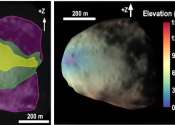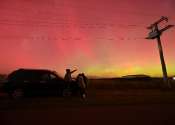Last update:
Planetary Sciences news

Scientists discuss why we might not spot solar panel technosignatures
One of NASA's key priorities is understanding the potential for life elsewhere in the universe. NASA has not found any credible evidence of extraterrestrial life—but NASA is exploring the solar system and beyond to help ...
Astrobiology
2 hours ago
1
5

Scientists pin down the origins of the moon's tenuous atmosphere
While the moon lacks any breathable air, it does host a barely-there atmosphere. Since the 1980s, astronomers have observed a very thin layer of atoms bouncing over the moon's surface. This delicate atmosphere—technically ...
Planetary Sciences
4 hours ago
0
5

Massive solar wind disturbance caused Earth's magnetosphere to fly without its usual tail
Like a supersonic jet being blasted with high-speed winds, Earth is constantly being bombarded by a stream of charged particles from the sun known as solar wind.
Planetary Sciences
8 hours ago
0
54

First full 2-D spectral image of aurora borealis from a hyperspectral camera
Auroras are natural luminous phenomena caused by the interaction of electrons falling from the sky and the upper atmosphere. Most of the observed light consists of emission lines of neutral or ionized nitrogen and oxygen ...
Planetary Sciences
9 hours ago
0
9

Study of comet A117uUD data suggests it was put on a 'hyperbolic trajectory' during pass by Saturn
A pair of astrophysicists from Ciudad Universitaria and Universidad Complutense de Madrid, both in Spain, report evidence that comet A117uUD was put on its current "hyperbolic trajectory" when it passed close to Saturn two ...

Venus' 'continents' suggest surprising link to early Earth
New research has revealed that Venus, often considered Earth's inhospitable twin, may share a surprising geological history with our own planet.
Planetary Sciences
10 hours ago
0
25

Astronomers use AI to find elusive stars 'gobbling up' planets
Astronomers have recently found hundreds of "polluted" white dwarf stars in our home galaxy, the Milky Way. These are white dwarfs caught actively consuming planets in their orbit. They are a valuable resource for studying ...
Astronomy
Aug 1, 2024
0
134

A unique combination of antennas could revolutionize remote sensing
Bigger antennas are better, at least according to researchers interested in geospatial monitoring. That's because higher resolution in monitoring applications requires larger apertures. So imagine the excitement in the remote ...
Planetary Sciences
Aug 1, 2024
0
16

A new study shows how the sun could permanently capture rogue planets
Interest in interstellar objects (ISOs) was ignited in 2017 when 'Oumuamua flew through our solar system and made a flyby of Earth. Roughly two years later, another ISO passed through our solar system—the interstellar comet ...
Planetary Sciences
Aug 1, 2024
0
31

Predicting solar storms before they leave the sun
When giant solar storms hit Earth, they trigger beautiful auroral displays high in Earth's atmosphere. There's a dark side to this solar activity, though. The "space weather" it sets off also threatens our technology. The ...
Planetary Sciences
Aug 1, 2024
0
14

NASA smacked a spacecraft into an asteroid—and learned details about its 12-million-year history
NASA's DART mission—Double Asteroid Redirection Test—was humanity's first real-world planetary defense mission.
Astronomy
Jul 31, 2024
0
31

How to SUPPPPRESS light from a star that is ten billion times brighter than its habitable exoplanet
Searching for Earth 2.0 has been an obsession of almost all exoplanet hunters since the discipline's dawn a few decades ago. Since then, they've had plenty of technological breakthroughs help them in their quest, but so far, ...
Planetary Sciences
Jul 31, 2024
0
18

Astrophysicists build model to explain to rapid planet formation
Our solar system is our immediate cosmic neighborhood. We know it well: the sun at the center; then the rocky planets Mercury, Venus, Earth, and Mars; and then the asteroid belt; followed by the gas giants Jupiter and Saturn; ...
Planetary Sciences
Jul 31, 2024
0
32

Additional planet orbiting the star TOI-1408 discovered
Using NASA's Transiting Exoplanet Survey Satellite, an international team of astronomers has detected a second planet orbiting a distant main sequence star known as TOI-1408. The newfound alien world, designated TOI-1408 ...

DART mission sheds new light on target binary asteroid system
In studying data collected from NASA's DART (Double Asteroid Redirection Test) mission, which in 2022 sent a spacecraft to intentionally collide with the asteroid moonlet Dimorphos, the mission's science team has discovered ...
Astronomy
Jul 30, 2024
0
177

The discovery of a new Earth-like planet could shed further light on what makes a planet habitable
In an exciting breakthrough for astronomy and the search for extraterrestrial life, a team of international scientists has announced the discovery of Gliese 12 b, a temperate, Earth-sized exoplanet just 40 light-years away—a ...
Astrobiology
Jul 30, 2024
0
52

Solar storms could cause more auroras
Massive explosions on the sun have triggered warnings of geomagnetic storms that could create dazzling auroras in the northern United States, Europe and southern Australia from Tuesday night.
Planetary Sciences
Jul 30, 2024
0
161

Study suggests cloud-to-ground lightning strikes may have generated building blocks for life on Earth
A large team of chemists at Harvard University has found evidence suggesting that cloud-to-ground lightning strikes may have helped generate some of the building blocks needed for life on Earth to arise.

Has NASA found evidence of ancient life of Mars? An expert examines the latest discovery
NASA has announced the first detection of possible biosignatures in a rock on the surface of Mars. The rock contains the first martian organic matter to be detected by the Perseverance rover, as well as curious discolored ...
Astrobiology
Jul 29, 2024
0
53

NASA Mars rover captures rock that could hold fossilized microbes
NASA's Perseverance Mars rover has made what could be its most astonishing discovery to date: possible signs of ancient life on the Red Planet.
Planetary Sciences
Jul 27, 2024
0
120
More news

Spacecraft to swing by Earth, moon on path to Jupiter

Is this how you get hot Jupiters?

How solar storms play havoc with our lives

What lunar caves tell us about the shared origins of the Earth and the moon

Image: A Saturnian summer

NASA's ICON mission ends with several ionospheric breakthroughs

Chinese lunar probe finds water in moon samples

NASA rocket discovers new energization process in upper atmosphere

Moon dust could contaminate lunar explorers' water supply
Other news

Coinfecting viruses obstruct each other's cell invasion

New compound found to be effective against 'flesh-eating' bacteria

Genetic signatures of domestication identified in pigs and chickens

New 'game-changing' discovery for light-driven artificial intelligence

Researchers demonstrate mechanism that may have stabilized the first RNA molecules

Machine learning discovers 'hidden-gem' materials for heat-free gas separation

Introducing Ramses, ESA's 2029 mission to asteroid Apophis

NASA's Curiosity rover discovers a surprise in a Martian rock

A new explanation for Jupiter's shrinking Great Red Spot

Ground conditions can impact lunar swirls, study finds


















































